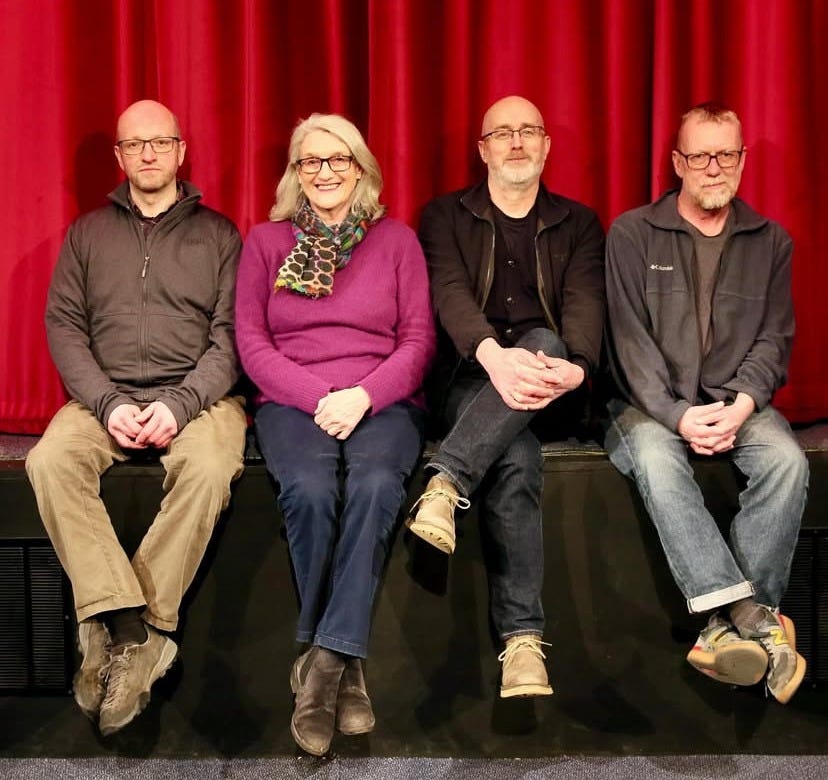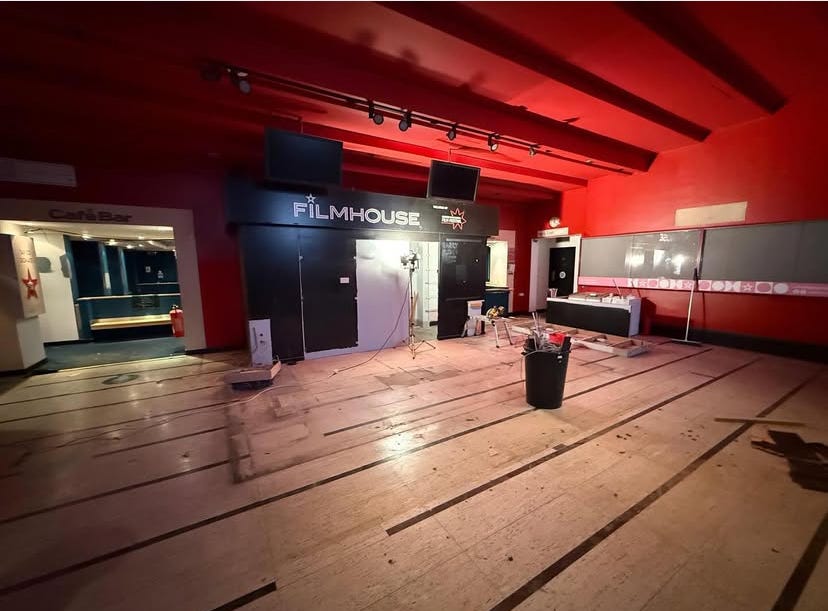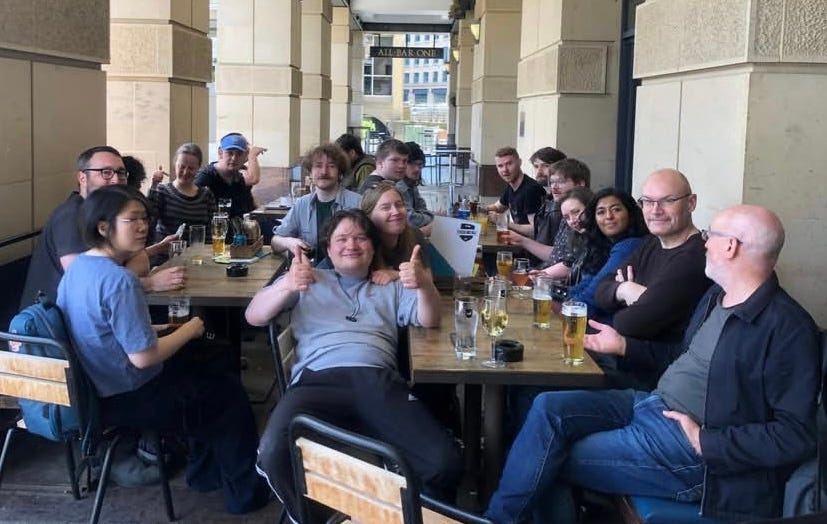Opening the doors of Edinburgh Filmhouse
How the city's ‘fantastic four’ helped save art house cinema from life as a theme pub

“The first thing I must emphasise is that I am not the leader. I happen to be somebody who has been around long enough that people have sort of gone, ‘we know you’.”
That’s Ginnie Atkinson talking, Chair of Filmhouse (Edinburgh) Limited, the company born around an All Bar One table at 10am on a December Monday in 2022. Two months earlier, the doors to the city’s bastion of international cinema, and the home of the world’s oldest continually running film festival, had closed with the collapse of previous owners, Centre for the Moving Image or CMI, writes Will Quinn.
Whilst the Edinburgh International Film Festival managed to reinvent its way into continued life, the lights went out at CMI’s two brick-and-mortar cinemas, Edinburgh Filmhouse and Aberdeen’s Belmont Cinema. This was a catastrophe for Ginnie, CEO of Filmhouse and Edinburgh International Film Festival until 2010, when CMI was created.
Edinburgh without the Filmhouse
“I woke up one morning about a week after that happened,” Ginnie tells me, “with a feeling of utter dread about the idea of Edinburgh not having the Filmhouse. I just couldn’t bear it.”
The roots of such a visceral reaction can be traced back to a mother who was a member in the 30s, 40s and 50s of the Film Guild, a film society with a history of organising film festivals and special screenings in Edinburgh. “It was the only way she could see international cinema.” Such formative experiences subconsciously underlined the idea of “a right of access.”
She cried for ice-cream when she was taken to the King & I too young, but by the time Peter O’Toole and Omar Sharif’s blue and brown eyes transfixed her throughout David Lean’s masterpiece, Lawrence of Arabia, she was ready to embrace the silver screen. A few decades later, her convictions have only grown.
“I believe this is true,” she states, “you might not go to the Filmhouse every week or even every month, but you’d fight to the death for the right to have it exist - for the greater good.” For Ginnie Atkinson, Edinburgh Filmhouse must survive.
She wasn’t alone in this feeling, but however well-attended and well-intentioned, the public meetings convened in pursuit of a Filmhouse rescue had left her cold.
“They were pretty chaotic, frankly, 'cause people started debating minutiae. And I’m thinking, ‘Well, do you want the Filmhouse back there, or don't you?’ There was no obvious leadership. David Smith (Director of Screen at Creative Scotland) observed as much to a couple of people.”
Then there were four
Hope was on hand in the shape of Filmhouse alumnus, Shetland Arts’ cinema programmer, Jenny Leask, who swooped down from the UK’s windiest isle to summon the Filmhouse’s “former pupils” to the pub.
“She used to get everybody to the pub, and I thought ‘I'll go along and see what's going on.’ And at the end of the evening, four of us were all staring at each other, saying, “Well, what are we going to do?’”
The four comprised Ginnie; former Filmhouse programme manager turned cinema strategist at Mustard Studio, James Rice; and the Filmhouse’s abruptly unemployed Heads of Programming and Technical, Rod White and David Boyd.
“So we were staring at each other at 11 o'clock, and a little drunk, saying, ‘What are we gonna do? What are we gonna do?’ And I said, ‘Well, we all know about this stuff so why don't we do something?’”
Then came All Bar One, and the long road to opening the doors again.
The long road to opening
Their first idea was a non-starter. “We all started with the same idea,” she recalls. “We had to buy the building, because it was then for sale.”
Cue a steep learning curve as the group negotiated the legalities and practicalities of a crowdfunding campaign. “We got masses of support, which told us that there was a massive amount of backing. But, long story short, we couldn’t collect enough money to make a realistic bid. So everybody got their money back.”
Cue a “weird lull over Christmas” whilst the team tried to find out who had actually bought the building. At first, it was only to satisfy their curiosity. Then, the idea of leasing the building struck, and finding out became imperative.
“We’d begun looking at whether we could lease the Odeon on Lothian Road, which in turn made us think, if we could find out who bought the Filmhouse, we could offer to lease it - take it off their hands - because it’s a tricky building.”
Whilst the new owners remained a mystery, local government regulations would give them a lifeline.

Council regulations can be a good thing
“One of the key factors in all of this is that Edinburgh has a set of ‘red zones’ as far as licenses and pubs are concerned. Luckily for us, Lothian Road is a red zone, and the council were not giving out any new licenses.”
Luckily for Team Filmhouse, the license that had existed for the building expired the previous October. “The administrators were in by then,” Ginnie tells me. “I think they were too caught up with everything else to notice. They also had no time, the company went into administration on the 6th of October, and the license renewal came up on the 8th. All it required was for someone to say ‘Yes, we want to continue’, but it didn’t happen.”
The first offer, it would transpire, was conditioned on the license being granted. The administrators applied, but wouldn’t find out till 31 January whether or not the council would play ball.
“So we spent Christmas not knowing what was going on. We had conversations with Odeon, but there wasn’t much going on. Meanwhile, we had all our ‘spies’ out in town and the corporate sector.” It would be another month before those spies finally provided Ginnie and Co. with the vital information they needed. A contact attending the elite Wooden Spoon charity lunch before that year’s Six Nations Rugby tournament found out city-based bar and hotel operator Caledonian Heritable’s unconditional offer had been accepted. That only happened after previous preferred bidders (said to be Signature Pub Group) dropped out when the council did not grant the all-important license.
According to Ginnie, the city dodged a bullet when that first bid failed. “They wanted to make it into a theme pub… they wanted to call it Filmhouse!”
A surprisingly helpful pub giant
With such an ignominious fate avoided, Ginnie quickly made contact with Caledonian Heritable, owners of a clutch of the city’s most-popular bars, including The Corinthian-pillared Dome on George Street.
With support from Creative Scotland, the Filmhouse four entered into lengthy negotiations, helped by Caledonian Heritable’s willingness to grant them the time to raise the money needed to pay the rent and refurbish the cinema.
As Caledonian Heritable put it, when asked, “It was an uphill battle which took an inordinate amount of time and effort to support the Filmhouse team in getting their capital funding back in place to allow them to proceed and open the doors.”
Having decided that “getting the original team back was the best decision” for their new property, the new owners of the Filmhouse would go even further. “We were allowed to use the building,” Ginnie says, “which meant we were able to do technical work for the next film festival, because the projection boxes had not been affected.”
Caledonian Heritable and its owner Kevin Doyle would contribute still more to the building’s continued life, as we will see, but maybe you, like me, are curious why this pub and hotel giant purchased the building in the first place?
“We felt it was important that Edinburgh maintained a long-standing Filmhouse, having the facility to train individuals…as well as showing new films and profiling new scriptwriters, directors, producers and their work.”
Doyle, owner of the Archerfield golf complex in East Lothian as well as a being one of the city’s major pub operators, is well known as one of the Capital’s most successful hospitality entrepreneurs. What is less well known about him is his genuine and abiding love of the arts.
What else to say other than… thank heavens for cinephiles with deep pockets and a sense of civic responsibility?
Money, Money, Money
Back with Ginnie and the Filmhouse’s would-be saviours, came Crowdfunder number two, entitled ‘Filmhouse – Open the Doors!’, launched in September 2023 after a meeting with fans, friends and cinema lovers. Donations began flooding in, but it wouldn’t be enough to satisfy their would-be landlords. Considerably more money was needed to bring the building back up to scratch to operate as a comfortable modern cinema.
That need led them to the UK Government’s (now shuttered) Community Ownership Fund, set up in 2023 to support “community groups to take ownership of assets and amenities at risk of being lost”. The ‘Open the Doors’ campaign fit the criteria, but it would take a month of “hard, hard, graft” to put the application together.
A month later, a call told them they’d been granted £1.5 million - “a totally brilliant breakthrough.” Thanks to the additional generosity of the locally based Nancie Massey Charitable Trust and other crucial major donors, they would eventually boast a budget of at least £2 million.
Not ones to let the grass grow beneath their feet, Ginnie, James, Rod, and David had already been in talks with cinema architects to draw up plans for the necessary works. They even recruited a fifth director, Mike Davidson CA, a strategic financial consultant. “That man deserves a gong,” Ginnie avers. “He’s our guiding light where it comes to the larger financial picture.”
Finally, in July 2024 a 25-year lease was signed, and in February this year contractor, Clark Contracts, began making their dreams a reality.
The wait was worth it. Caledonian Heritable had been busy themselves in the meantime, making essential repairs to the fabric of the building before handing it over. “Caledonian Heritable were getting in there. The building was a complete mess, and they repaired the roof, the stonework, and various other things. They’ve made it a lot better.”
Thus, when Clark’s Contracts walked in, all of those hard-won funds were put to work making the best cinema possible, rather than shoring up the consequences of many years of slow decay and inadequate maintenance. As Ginnie puts it, “It was smelly!” - a problem beyond the saving graces of the most outstanding interior design.
If this sounds at all too easy, Ginnie is keen to emphasise the abundant support she and the team found along the way. That ranged from volunteers to celebrity backers such as Emma Thompson, Dougray Scott and Jack Lowden.
“We’ve had a huge amount of support, be it development funding from Screen Scotland, or the unstinting backing of all parties in the City of Edinburgh Council. Indeed, we had to submit our business model to give them confidence - they weren’t just giving their support away. I think this, in turn, gave confidence to Caledonian Heritable. In all, it’s been a surprisingly positive journey, though not without plenty of work and travails. But we’ve had the wind at the back o’ us, and luck such as the licensing issue.”
Who to thank?
When the Filmhouse reopens, it will do so with four screens, not just the original three. When it does, Ginnie will be the last to accept any credit, pointing instead to the “amazing” James Rice. “He’s virtually the finance manager until the actual finance manager starts…” Or Rod White: “He’s dealing with all the bureaucracy because we have to track a whole load of things. He’s opened three bank accounts - that’s a job - that’s a nightmare.” Or David Boyd, who she credits with dealing with the building needs: “What this has turned out to be is a very fortuitous set of complementary skills and experience amongst five people.”
What about Ginnie? “Oh, I just tend to do comms,” she says. One suspects her light is being hidden behind a cinema-sized bushel.
Better this time?
When those doors open again, what will make this incarnation of Edinburgh Filmhouse succeed? Ginnie isn’t shy with an answer: “Well, first, it’s unique.”
When asked for a little more, Ginnie outlines a clear rationale for a thriving future. Central is the building’s unique capacity - technically and culturally - to serve as a home for specialised cinema and its audiences.
“It’s equivalent to having the BFI NFT [National Film Theatre] in Edinburgh,” she says, referencing the UK’s flagship venue for film. She points to the Filmhouse’s technical capabilities, which include 70mm, 35mm, 16mm and digital projection. “We’ve probably got 8mm if we needed it,” she adds, whilst also noting the presence of an eyewateringly expensive Clipster Unit, a device used to create Digital Cinema Packages (DCPs) - the standard format for festival and theatrical distribution.
These facilities, she argues, make the Filmhouse an essential partner for many of Scotland’s smaller film festivals, which typically lack suitable homes. “We offer a proper technical and marketing package for the French, Italian, Spanish, Scotland Loves Anime, Take One Action, Africa in Motion…” she lists, noting that such partnerships bring a wider range of programming and audiences to the venue.
Reflecting on the closure, Atkinson describes the impact on those festivals and their audiences as significant. “There was chaos,” she says, when it became clear that alternatives could not replicate what the Filmhouse had offered. “People who didn’t quite understand used to say, ‘Well, why bother?’ Well, because we are different. Our programme is incredibly different, as well as all the technical stuff.”
The Filmhouse, she suggests, serves a specific function in Edinburgh’s cinema ecology, not only in terms of content and curation, but also in its abundance. The daily programme, she recalls, featured between “60 and 80 titles a month,” with a strong focus on repertory work and international cinema.
Alongside this, she emphasises the Filmhouse’s education and outreach activity. A Learning & Engagement Officer has already been appointed, supported by a grant from the City of Edinburgh Council. Atkinson also points to a forthcoming partnership with the National Film and Television School’s Sean Connery Talent Lab, whose graduation shows will take place at the Filmhouse this summer. “It’s not just meant to be a home for cinephiles in a fancy way,” she says. “We came up with a phrase, the ‘Film Curious’. That covers anybody from a 15-year-old who wants to see a bit more than the latest Marvel film right up to an 80-year-old who wants more than that too.”
As she puts it, the case for the Filmhouse’s return rests not only on nostalgia, but on a belief in what the venue still has to offer. “These are the bases of why we think - it’s the cultural imperative - the wider vision of the world. We’ll go to a lot of trouble to make it work.”
And the smell will definitely be gone
Edinburgh Filmhouse will be the same… but better.
“The bricks and mortar will be shining,” she says, “but one of the basic tenets of our submitted business model is that we have to attract new audiences.”
So, how will Edinburgh Filmhouse (don’t place a ‘the’ in front of it when talking to any of the faithful) achieve this? The answer - it’s the seats, stupid! (My words, not Ginnie’s)
“Some people had gotten truly fed up with the seats, with their knees pushed up to their chests whilst the rest of them sank into the floor. Improving that was one of the fundamental things - and one of the reasons we didn’t just want to raise a few hundred thousand so we could get a skeleton staff and try again in the ghastly physical circumstances.”
When Ginnie says ‘we’, she means those amongst the ‘Open the Doors’ team who saw no future in a “nostalgic approach to business”. Ginnie is certain that without this bigger ambition, they wouldn’t have attracted the level of public support or vital multi-year funding from Creative Scotland announced earlier this year.
Don’t expect endless legroom, but those extra four inches per seat will be welcome to many. It’ll mean 100 fewer seats in the largest screen, Cinema 1, but Ginnie has no doubts it’ll be worth it.
On top of that “the Café-Bar is being completely refurbished, and the foyer is being completely redone. People will definitely notice it’s new.” If you’re worried about the revolution going too far, Ginnie offers reassurance. “The programme - and the nachos - will remain. We’re not doing anything radical with the spaces, it’s not going to look like a hotel. It certainly isn’t going to be alienating or ‘posh’.”
Not everything in the new Filmhouse will be perfect, of course (and thank goodness). Ginnie’s bracing for what she calls “a mixed reaction” once the doors reopen, especially from patrons familiar with the building’s quirks. Transparency, it seems, is key. “I’m laughing and saying what we need is a card on the tables in the café bar saying ‘This is a list of excuses. Like, why have we still got three cubicles in a space better suited to two? Well, the license for the building requires us to have a certain number of toilets, and the space isn’t infinite.”
The same logic, she adds, applies to the improved legroom. “People may want to know why the legroom isn’t infinite, well, because we need so many seats to pay the bills.”
Still, comfort has been prioritised. “I’ve always said the café bar is the most pertinent aspect of it all. Lots of people come in and either go ‘this is lovely’ or ‘I don’t like that colour’, but it comes down to the food. Well, the chef started this morning.”
A soft launch is planned for June, with reduced prices and a warm invitation for public feedback. “People should feel free to give genuine feedback, we want to know what people think.” Reader, I’ll be there - I am a critic after all.
Affordable seats and a wide programme
Cinephiles can relax, ambitions at the new Filmhouse extend beyond the menu of course. “We’re going to have membership offers, multiple-tier ticket pricing which we’ll refine over time, and membership is really important,” says Ginnie. “Soon, we’re going to be selling seats. There’s much to do.”
She’s particularly keen to distinguish the Filmhouse’s ethos from the rising costs of mainstream cinema. “We have good intent around all of this, and cinemas, well, it’s easy not to be the Everyman.”
At the time of writing, a regular ticket at said luxury cinema within the St James Quarter comes in at a cool £16.95. It’s good to know Edinburgh Filmhouse will price itself below this.
There’s talk, too, of expanding the programme. “We’re also looking at the National Theatre Live, or the Metropolitan Opera Live broadcasts, though nothing is confirmed yet. These are things we certainly didn’t do before.”
There’s no denying Ginnie’s sense of optimism. “It’s going to be fantastic. It’s exciting. I suppose what you could say, if you turned a bit Pollyanna, is that we’ve turned a tragedy into a triumph, potentially. I don’t mean we’ve done that, but in the end it was a horrendous, probably unnecessary situation, and it has become an opportunity to make it better.
“We still have to pay a lot of rent, but apart from that, it’s good. And we’ll be independent.”
This re-separation from the Film Festival, Ginnie believes, is another particular good. “It’s absolutely the right move. Of course, we can continue with a very close working relationship. We have a cultural mission which crosses over entirely. But a festival is a different kind of presentation and quite costly - and having been managing director of the Film Festival, I ken how expensive it is.”
That clarity, she says, is essential. “I think it’s very much better if it’s clean and clear. That is a festival - it’s very important - people fund it. Filmouse is a 365-day-a-year audience development and satisfaction business.”
And here’s what you’ve missed…
What will Filmhouse be showing to satisfy its customers when the doors open? Well, all of the films that didn’t get shown in Edinburgh, whilst we were closed. I think that speaks for itself.”
And the plan to follow? “What Filmhouse’s plan is - is to do what we’ve always done, but with a little more legroom. The same high-quality, wide-ranging programme, but with a little more legroom, but not global legroom.”
When Edinburgh Filmhouse finally reopens - probably this June - it will do so with a new senior management structure. New Executive Director Andrew Simpson, former head of film at the Tyneside Cinema in Newcastle, will join returning programme director Rod White at the helm, giving programme and operational management equal status. WhilstDavid Boyd will return to his former role overseeing the technical side, Ginnie and the rest of the ‘Open the Doors’ team will slow down a bit to just being company directors.
In the unlikely event that Ginnie Atkinson does find a slower gear, one wishes her time in the cinema which she helped to save… and many an opportunity to enjoy the legroom.






Reader, I’ll be there too. Well done to all the team who have made this possible - and to Kevin Doyle as well